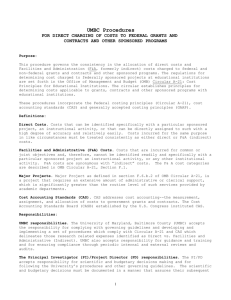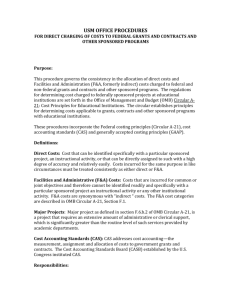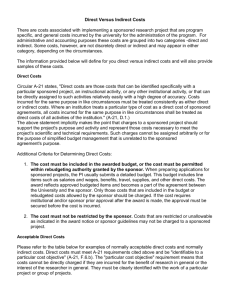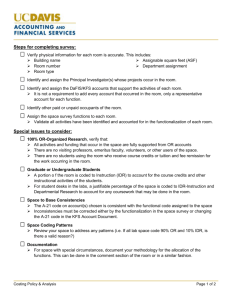Overview of A-21 Requirements for Charging Direct Costs
advertisement
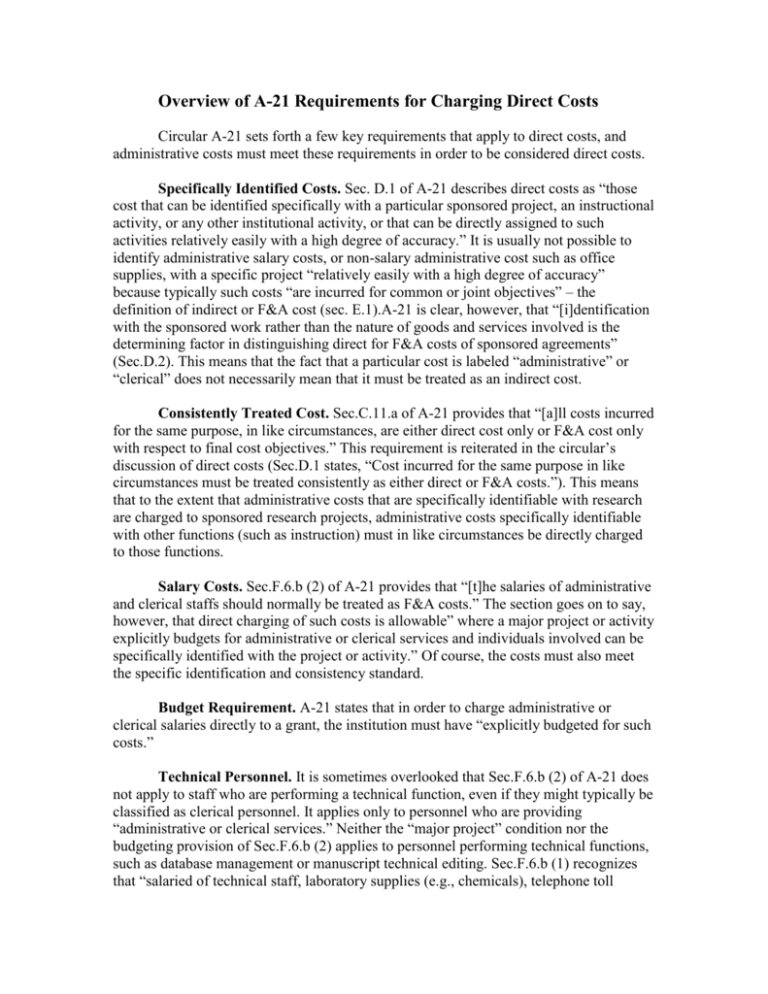
Overview of A-21 Requirements for Charging Direct Costs Circular A-21 sets forth a few key requirements that apply to direct costs, and administrative costs must meet these requirements in order to be considered direct costs. Specifically Identified Costs. Sec. D.1 of A-21 describes direct costs as “those cost that can be identified specifically with a particular sponsored project, an instructional activity, or any other institutional activity, or that can be directly assigned to such activities relatively easily with a high degree of accuracy.” It is usually not possible to identify administrative salary costs, or non-salary administrative cost such as office supplies, with a specific project “relatively easily with a high degree of accuracy” because typically such costs “are incurred for common or joint objectives” – the definition of indirect or F&A cost (sec. E.1).A-21 is clear, however, that “[i]dentification with the sponsored work rather than the nature of goods and services involved is the determining factor in distinguishing direct for F&A costs of sponsored agreements” (Sec.D.2). This means that the fact that a particular cost is labeled “administrative” or “clerical” does not necessarily mean that it must be treated as an indirect cost. Consistently Treated Cost. Sec.C.11.a of A-21 provides that “[a]ll costs incurred for the same purpose, in like circumstances, are either direct cost only or F&A cost only with respect to final cost objectives.” This requirement is reiterated in the circular’s discussion of direct costs (Sec.D.1 states, “Cost incurred for the same purpose in like circumstances must be treated consistently as either direct or F&A costs.”). This means that to the extent that administrative costs that are specifically identifiable with research are charged to sponsored research projects, administrative costs specifically identifiable with other functions (such as instruction) must in like circumstances be directly charged to those functions. Salary Costs. Sec.F.6.b (2) of A-21 provides that “[t]he salaries of administrative and clerical staffs should normally be treated as F&A costs.” The section goes on to say, however, that direct charging of such costs is allowable” where a major project or activity explicitly budgets for administrative or clerical services and individuals involved can be specifically identified with the project or activity.” Of course, the costs must also meet the specific identification and consistency standard. Budget Requirement. A-21 states that in order to charge administrative or clerical salaries directly to a grant, the institution must have “explicitly budgeted for such costs.” Technical Personnel. It is sometimes overlooked that Sec.F.6.b (2) of A-21 does not apply to staff who are performing a technical function, even if they might typically be classified as clerical personnel. It applies only to personnel who are providing “administrative or clerical services.” Neither the “major project” condition nor the budgeting provision of Sec.F.6.b (2) applies to personnel performing technical functions, such as database management or manuscript technical editing. Sec.F.6.b (1) recognizes that “salaried of technical staff, laboratory supplies (e.g., chemicals), telephone toll charges” and other items “shall be treated as direct cost[s] wherever identifiable to a particular cost objective.” Non-Salary Admin Costs. Sec.F.6.b.3 of A-21states that, “Items such as office supplies, postage, local telephone costs, and memberships shall be treated as F&A costs.” These administrative cost are “normally” treated as F&A costs because they typically represent the kind of costs “that are incurred for common or joint objectives and therefore cannot be identified readily and specifically with a particular sponsored project, an instructional activity, or any other institutional activity” (Sec.E.1). There are some cases, however, where a non-salary administrative cost can be “identified readily and specifically with a particular sponsored project,” and in such cases, the cost may be charged directly. A-21 makes it clear that whether a particular cost can be “identified” with a particular sponsored project does not depend on the nature of the charge (e.g., administrative vs. technical): “Identification with the sponsored work rather then the nature of the goods and services involved is the determining factor in distinguishing direct from F&A costs sponsored agreements” (Sec.D.2). Major Projects. Sec.F6.b (2) of A-21 defines major project as “a project that requires an extensive amount of administrative or clerical support, which is significantly greater than the routine level of such services provided by academic departments.” Exhibit C to A-21 provides six examples of major projects “where direct charging of administrative or clerical staff salaries may be appropriate”: (1) Large, complex programs such as general clinical research centers, primate centers, program projects, environmental research centers, engineering research centers, and other grants and contracts that entail assembling and managing teams of investigators from a number of institutions. (2) Projects that involve extensive data accumulation, analysis and entry, surveying, tabulation, cataloging, searching literature, and reporting (such as epidemiological studies, clinical trails, and retrospective clinical records studies). (3) Projects that require making travel and meeting arrangements for large numbers of participants, such as conferences and seminars. (4) Projects whose principal focus is the preparation and production of manuals and large reports, books and monographs (excluding routine progress and technical reports). (5) Projects that are geographically inaccessible to normal departmental administrative services, such as research vessels, radio astronomy projects, and other research field sites that are remote from campus. (6) Individual projects requiring project-specific database management; individualized graphics or manuscript preparation; human or animal protocols; and multiple project-related investigator coordination and communications. It’s worth nothing that examples #2, #3, #4, and #6 relate to projects that may not involve inherently large or complex programs, but that nevertheless have specific requirements that make it necessary to use unusual amounts of types of administrative or clerical services. Exhibit C makes it clear that the examples presented are not exhaustive. There can be other circumstances in which the “major project” designation would be appropriate.

